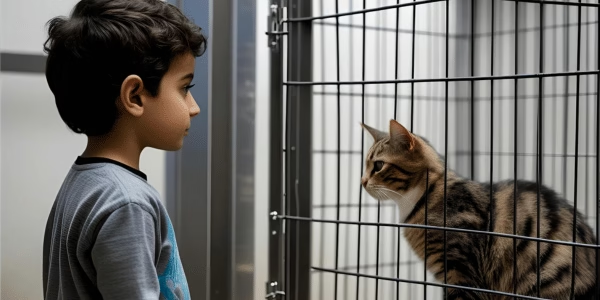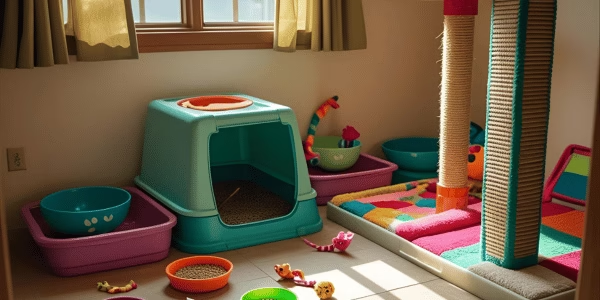Welcoming a cat into your family is more than just picking a cute companion—it’s about making a choice that aligns with your lifestyle, your space, and your household dynamic. With the right preparation, your family can find a cat that fits seamlessly into your lives and becomes a beloved member of the household.
Whether you’re new to pet adoption or adding to an existing fur family, this guide will walk you through how to choose the right cat—especially from a shelter or rescue. From understanding feline behavior to preparing your home, every step matters in ensuring a successful, happy adoption.
Why Your Family’s Choice of Cat Is So Important
Cats may seem easygoing, but that doesn’t mean any cat will thrive in any home. Temperament, history, age, and even grooming requirements can significantly impact how well a cat adapts to your family.
According to the ASPCA, over 3 million cats enter shelters in the U.S. each year. While many find homes, a number are returned due to preventable mismatches—often because the cat didn’t suit the adopter’s lifestyle.
Taking time to understand what makes a good match can mean the difference between a joyful addition and an unfortunate surrender.
As this article is focused on choosing the right cat, we have a Complete Cat Adoption Guide that you can read if you have questions about the adopting process.
Step 1: Evaluate Your Family’s Habits and Environment
Your household routine plays a major role in determining what kind of cat will fit in best.
Daily Rhythm and Noise Level
Some cats are shy or skittish and prefer calm environments, while others are social butterflies that thrive in active homes with children or guests coming and going.
- Busy household: Outgoing, confident cats
- Quiet home: Reserved or senior cats
Children and Other Pets
Not every cat is child-tolerant, and some may be uncomfortable around dogs or other animals. Be upfront with the shelter about who lives in your home.
Your Time Commitment
While cats are less demanding than dogs in terms of walks and training, they still need engagement, enrichment, and care.
Ask yourself:
- Who will handle litter box duties?
- Is your family available for play and affection?
- Can you manage occasional vet visits and grooming?
If you have kids I highly suggest you to read my article 10 Factors to consider when adopting a cat for a family with children
Step 2: Decide What Kind of Cat You Want—But Stay Flexible
It’s okay to start with preferences, but keep in mind that personality often matters more than appearance.
Age Considerations
| Age | Traits | Pros | Challenges |
| Kitten | Playful, curious | Can grow with your family | Requires training, supervision |
| Adult | Temperament is clear | Often calmer, litter-trained | Might need an adjustment period |
| Senior | Gentle, low energy | Ideal for quieter homes | May need more medical care |
If your kids are very young, a tolerant adult cat may be safer than an energetic kitten with sharp claws and endless curiosity.
Coat Type and Grooming
A cat’s coat affects both care and your household environment.
| Coat | Maintenance | Ideal For |
| Short Hair | Minimal brushing | Families looking for simplicity |
| Medium Hair | Brushing 2–3x per week | Families okay with light maintenance |
| Long Hair | Daily grooming | Households ready to bond through grooming |
If allergies are a concern, look into breeds known to produce fewer allergens, such as the Siberian or Balinese—but no cat is truly hypoallergenic.
Step 3: Focus on Personality Over Breed
While breed characteristics can offer some guidance, cats are highly individual—especially in a shelter setting. That’s why it’s best to prioritize personality over pedigree.
Common Feline Temperaments
| Personality Type | Great For | Traits |
| Affectionate | Families with kids or seniors | Seeks attention, cuddles |
| Independent | Working families | Content alone, low-demand |
| Playful | Active households | Energetic, curious |
| Shy or Timid | Quiet homes | Needs patience, often very loyal once bonded |
Shelter Staff Observations Matter
Most shelter workers and foster parents spend time observing each cat’s habits, preferences, and behavior. They can often tell you:
- Whether the cat likes being held
- How it reacts to loud sounds or other pets
- If it’s prone to anxiety or aggression
Ask these questions, and trust their advice over assumptions based on breed or looks.
Step 4: Start Your Search with Reputable Sources
There are many places to find adoptable cats, but not all are equal. Stick with reputable shelters and rescue organizations that prioritize the well-being of animals and transparency with adopters.
Top Places to Search:
- Petfinder
- Adopt-a-Pet
- Best Friends Animal Society
- Local SPCAs, humane societies, and cat-specific rescues
Step 5: Visit Cats in Person (or Virtually) Before You Decide
Pictures and bios can be helpful, but there’s no substitute for seeing how a cat behaves in real-time. If you can, visit the shelter with your family. If in-person visits aren’t possible, ask for video introductions or virtual meet-and-greets.
Watch how the cat:
- Responds to your voice
- Interacts with toys
- Reacts to new people
Sometimes the “right” cat is the one that chooses you—not the one you planned to adopt.
Step 6: Ask the Right Questions
Before committing, get clarity on the cat’s background, habits, and any known needs.
Key Questions to Ask Shelter or Rescue Staff:
- Is this cat comfortable around children or other animals?
- Does the cat have any health issues or medications?
- What’s its energy level like?
- Is the cat litter box trained?
- Has it shown any signs of aggression or fear?
The more you know, the smoother your transition will be once the cat comes home.
Step 7: Prepare Your Home for a Smooth Transition
Before bringing your new cat home, set up a space where they can decompress and feel secure.
Cat Essentials to Set Up:
- Litter box (avoid scented litter at first)
- Food and water bowls (or fountain)
- Cat bed or hideaway
- Scratching post
- Toys (variety of textures and styles)
- Carrier
- Window perch or elevated shelf
Start your cat in one quiet room. Gradually give them access to more of the house once they feel safe.
Step 8: Introduce the Cat to the Family Carefully
The introduction period is crucial—especially in a family with kids or other pets.
Tips for Introducing Cats to Kids:
- Let the cat come to them; don’t chase or force interaction
- Teach children to speak softly and move slowly
- Use toys to encourage interactive play
- Always supervise early interactions
Other Pets in the Home?
- Keep them separated at first
- Swap items between rooms to introduce scent
- Use short, controlled meetings to avoid stress
Gradual exposure leads to more successful integration.
Step 9: Support Your New Cat with Ongoing Care
Cats are fairly low-maintenance, but they still need structure, attention, and stimulation to stay happy and healthy.
Daily and Weekly Needs:
- Scoop litter daily
- Refresh food and water
- Spend time playing—chase toys, puzzle feeders, or wand games
- Groom regularly based on coat length
Health & Vet Care:
- Annual vet checkups and vaccinations
- Parasite prevention
- Spay/neuter if not already done
- Dental cleanings as needed
You might also consider pet insurance from providers like Lemonade or Trupanion to help cover vet expenses.
Should You Adopt More Than One Cat?
In some cases, adopting a pair—especially bonded kittens or siblings—can reduce boredom, provide comfort, and help with social development.
Signs that a second cat may be a good idea:
- You’re away from home often
- The cat is young and highly playful
- You’re open to more responsibility
Always ask the shelter if any bonded pairs are available, or if the cat you’re considering would thrive with a companion.
Common Pitfalls to Avoid
- Choosing Based on Looks Alone
The prettiest cat in the room may also be the most nervous or high-maintenance. Prioritize behavior and compatibility. - Overestimating Independence
Cats are often mislabeled as “easy.” While they don’t need walks, they do need attention, play, and love. - Forgetting to Cat-Proof
Make sure you’ve secured cords, removed toxic plants, and hidden valuables—curious cats explore everything.
Conclusion: The Best Cat Is the One That Matches Your Life
Adopting a cat is a joyful, life-changing experience—when it’s done thoughtfully. The perfect cat for your family isn’t the most playful, rarest breed, or fluffiest—it’s the one whose personality and needs align with your household.
By taking your time, asking the right questions, and preparing your home properly, you’re setting the stage for years of affection, fun, and companionship.
The right cat isn’t just a pet—it’s family.






